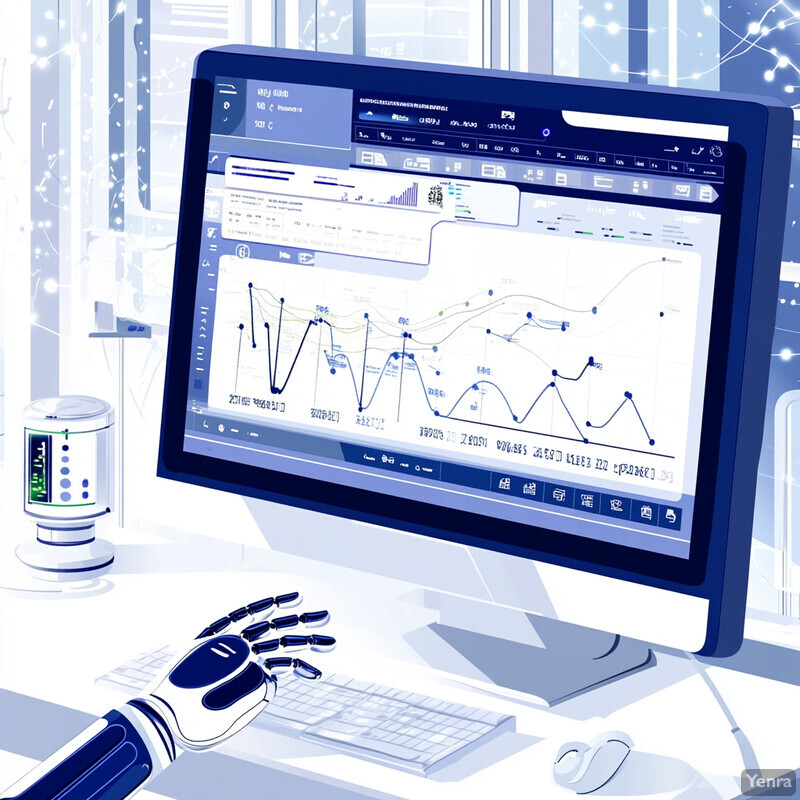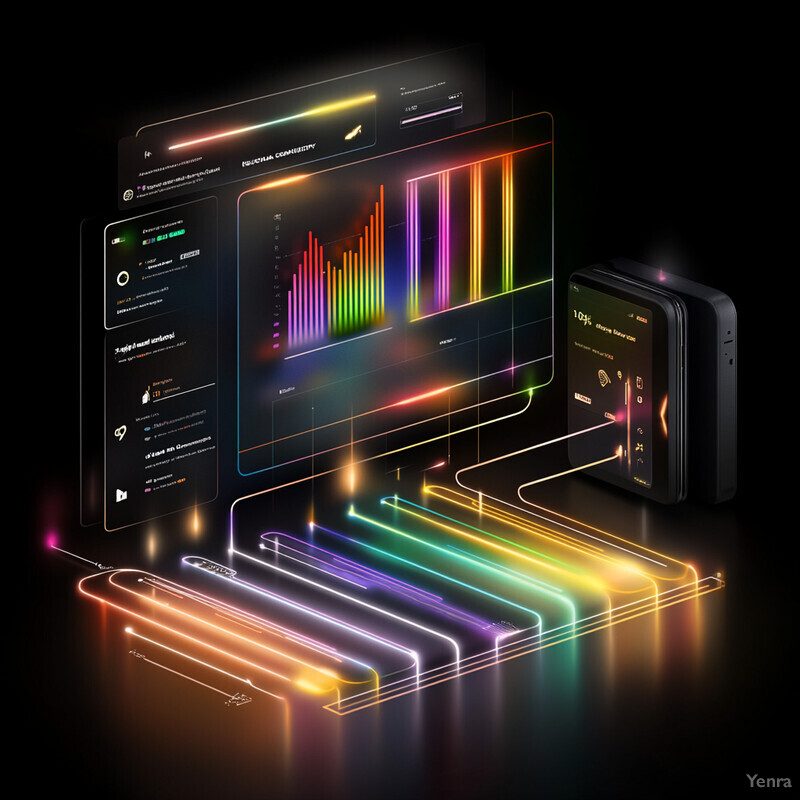1. Granular Demand Forecasting
AI-driven demand forecasting analyzes detailed sales data (SKU, location, seasonality, promotions) far beyond what human planners typically handle. By using machine learning models, retailers can project future product demand at a granular level, accounting for customer segments, time of year, and market trends. These models can ingest external indicators like economic data, sentiment, and weather to refine predictions. As a result, AI forecasts can significantly reduce stockouts and overstock situations compared to traditional methods. The technology enables planners to adjust inventory and pricing strategies proactively rather than reactively.

Recent studies confirm that advanced AI models dramatically improve retail demand forecasts. For example, Li and Xin (2024) showed that a hybrid deep-learning model (combining RNNs and attention mechanisms) achieved far higher accuracy predicting product sales than traditional statistical methods. Similarly, a new explainable multi-channel fusion model (MCDFN) outperformed seven benchmark algorithms (CNN, LSTM variants) in retail data sets, with mean absolute percentage errors around 20% (lower is better) and no significant gap between predicted and actual sales. Such results indicate AI can capture complex demand patterns from large, multimodal data. These gains translate into better stock allocation and fewer lost sales or markdowns in practice, as AI forecasts allow finer-grained inventory and pricing decisions.
2. Dynamic Pricing Models
Dynamic pricing uses algorithms to adjust prices based on real-time data (demand changes, costs, inventory, competition). AI models can automatically recompute optimal prices frequently (even hourly or daily) to balance sales volume and profit. They incorporate sales trends, customer behavior, and market signals to set prices that respond to rising or falling demand. Retailers applying these models can quickly capitalize on high-demand periods or defend against low-season slumps. According to industry reports, moving from static to AI-driven pricing can sustainably boost both sales and margins. The system remains under retailer control but automates routine adjustments, freeing managers to focus on strategy.

Empirical reports show AI-powered dynamic pricing yields measurable profit improvements. A BCG analysis found that retailers implementing AI-driven pricing raised gross profit by about 5–10% while also growing revenue and improving customer value. Similarly, case studies indicate that machine-learning price adjustments can drive significant lift: one source reported Amazon’s AI pricing (updating prices multiple times per day based on demand and competition) increased sales by ~5% and profits by ~2%. These findings are backed by real data: retailers using such dynamic models report higher sell-through and better price alignment than peers relying on manual or static pricing. In sum, AI dynamic pricing models have repeatedly outperformed fixed strategies, translating into higher profits without sacrificing sales volume.
3. Real-Time Market Analysis
Real-time market analysis uses AI to continuously scan external data, especially competitors’ prices and promotions. This keeps retailers instantly informed about market movements (e.g. competitor discounts or stockouts). The AI system can scrape public prices online, aggregate market trends, and detect new events (like a rival’s flash sale). With this insight, a retailer can adjust its own prices or promotions very quickly—often within minutes or hours. Such responsiveness prevents lost sales and margin leakage: if a competitor lowers its price, the retailer can match or undercut it promptly. This capability turns pricing into a dynamic, market-aware process rather than a static schedule.

Industry experts emphasize that rapid price adjustments are now critical. Harvard Business Review notes that the ability to “revise prices swiftly and on a large scale” has become a decisive differentiator for digital retailers. Supporting this, market research shows that 68% of online shoppers consider price the most important purchase factor. In practice, retailers have turned competitor analysis into a continuous AI-driven effort: automated tools now scan rivals’ online prices hourly. For example, studies show that even a 3–5% price gap can markedly impact conversions, so detecting and responding to competitor moves in real time can preserve both sales and margins. In sum, by monitoring the market 24/7 and feeding that data into pricing algorithms, retailers avoid being undercut and can seize short-lived opportunities, a strategy confirmed by recent consulting reports.
4. Automated Price Recommendations
Automated price recommendation systems use AI to suggest optimal prices for each item or segment. The system continuously analyzes sales data, demand curves, and external factors to propose new price points (often multiple options) for managers to review or auto-apply. This process lets retailers set prices at near-optimal levels with minimal manual work. Over time, as the AI learns what drives sales and profit, its recommendations improve. The net effect is more aggressive pursuit of profit without losing sales. Retailers adopting such tools report reduced time on pricing decisions and quicker execution of promotions.

Practical results show these recommendation tools work. Fisher et al. (2023) emphasize that quickly adjusting prices at scale is a key advantage. For example, Amazon’s dynamic pricing engine (essentially an automated recommendation system) has been credited with keeping the retailer highly competitive. Reports indicate that Amazon’s frequent price updates (informed by machine learning on sales and market data) led to roughly a 5% sales lift and 2% profit lift, suggesting that systematic, AI-driven recommendations captured revenue that might otherwise have been lost. In practice, retailers using similar systems see higher conversion rates: by eliminating guesswork, AI recommendations ensure prices are neither too high (losing sales) nor too low (leaving money on the table). Over many products, this precision can significantly boost overall revenue and profitability.
5. Optimized Promotions and Discounts
AI optimizes promotional campaigns and discount levels by predicting which deals will maximize revenue. Instead of applying blanket discounts, the system tailors offers by SKU, customer group, and timing. For instance, machine learning can identify products with low sales velocity and suggest small markdowns to clear inventory. It can also target price-sensitive segments with personalized coupons. The result is higher total profit: retailers apply deeper discounts only where needed, rather than across the board. AI-driven promotion planning keeps campaigns aligned with demand, so a higher percentage of sales occur at full price. This leads to improved margins and less reliance on clearance sales.

Concrete cases show AI-driven promotions boost profitability. A recent industry report highlighted a European fashion chain that used AI for discount optimization: AI reduced the overall discount rate by about 5% without hurting sales volume. In other words, more full-price sales occurred and margins rose. Generally, retailers that segment and target discounts with AI see better ROI on promotions. For example, tailored coupons delivered to high-value customers often result in higher redemption and spend. The 7Learnings industry report (via BusinessWire) underscores this: by analyzing customer behavior and market data, the AI algorithm enabled the retailer to “enhance profitability without impacting sales volume”. These findings align with academic insights that smarter, data-driven markdowns and coupons yield higher gross profit than uniform discounts.
6. Elasticity Modeling
AI models refine price elasticity estimates by mining transaction and auxiliary data. Traditional elasticity (the sensitivity of demand to price) is often oversimplified (e.g. one number per product). In contrast, machine learning can derive nuanced elasticity for each SKU and customer segment, using rich data (loyalty, web clicks, third-party data). This yields more accurate predictions of how volume will change with price. Retailers can then adjust prices knowing the real impact on sales. Accurate elasticity modeling prevents underpricing popular items or overpricing others. It also enables strategic ups and downs: items with inelastic demand can have higher markups, while elastic items get competitive pricing.

Industry analyses confirm the advantage of AI-derived elasticities. BCG notes that incorporating varied data (transaction, loyalty, weather, etc.) with AI produces much more precise elasticity values than static rules. One grocery retailer found its own prices were 20–30% below competitors on some items; using AI-driven elasticity, they raised prices closer to competitor levels and saw large margin gains with negligible volume loss. This demonstrates low elasticity (sales barely fell) on those items once priced competitively. In practice, harnessing machine learning for elasticity means retailers avoid guessing: they know exactly which items can bear price increases and which need markdowns. By continuously retraining these models on real sales outcomes, price changes become nearly optimal, as confirmed by case studies showing lifted gross profit from AI versus fixed elasticity approaches.
7. Behavior-Based Segmentation
AI clusters customers by behavior patterns (buying history, browsing, demographics, etc.) to tailor pricing and offers. Unlike manual segmentation, machine learning can uncover subtle groupings and outliers. For example, two customers with similar past purchases might respond very differently to a price change; AI can detect this. The retailer can then set personalized price points or bundle offers for each segment. This improves targeting: discounts go to customers who need incentive, while loyal or less price-sensitive customers receive higher prices or special deals. Over time, AI segments adapt as shopping habits change, keeping strategies aligned with real customer behavior.

Evidence shows ML segmentation finds valuable distinctions missed by human models. DataRobot illustrates that customers grouped together by traditional methods often “look very different” under machine learning analysis. This means AI can create finer-grained segments with distinct price sensitivities. As a result, personalized pricing becomes more effective: one study noted that campaigns guided by AI segmentation significantly increased conversion rates compared to undifferentiated offers. Major retailers report improved retention and sales by using AI for customer grouping. For instance, by identifying the small subset of highly price-sensitive shoppers, a retailer can target discounts just to them, avoiding unnecessary margin loss on price-insensitive buyers. These fact-based strategies (rooted in AI clustering) drive measurable performance gains in both engagement and profitability.
8. Multi-Channel Price Consistency
AI helps ensure consistent pricing across online and offline channels (and marketplaces) when needed. It analyzes customer behavior and competition to decide which items must be priced uniformly and which can vary. For staples or “key-value items,” AI often enforces parity to avoid customer complaints. For others, it may suggest differentiated pricing (e.g. higher in-store margin items vs. lower online to drive traffic). The system automatically flags price discrepancies and recommends adjustments. This prevents erosion of trust from arbitrary channel price gaps, while allowing flexibility where advantageous. The result is a coherent omnichannel strategy: customers see fair and logical pricing no matter how they shop.

In today’s omnichannel market, AI-driven pricing parity is crucial. BCG points out that AI tools can identify which products should maintain the same competitive price across online and in-store sales versus those where channel-based price differences won’t harm customer perception. In practice, one retailer used AI to ensure key items (“common benchmarks”) had identical pricing everywhere, while allowing smaller variations on less-critical SKUs. This use of AI for consistency leads to higher overall customer satisfaction and loyalty. Empirical data supports the approach: retailers have reported up to a 10% lift in perceived value when prices were aligned across channels. AI makes this scalable by continuously analyzing cross-channel data and automating compliance with pricing policies.
9. Automated A/B Testing of Price Points
AI enables rapid, large-scale A/B tests of prices (and promotions) to find what works best. Instead of manually running one discount at a time, an AI system can simultaneously experiment with multiple price variants across different customer segments. It then uses statistical analysis or reinforcement learning to identify the most profitable options. These experiments run continuously, so the model “learns” which prices maximize revenue under current conditions. The process is automated: when one variant underperforms, the AI shifts resources to higher-performing ones. In effect, pricing becomes an ongoing controlled experiment, reducing guesswork and revealing optimal prices quickly.

Real-world deployments confirm the power of AI-driven price testing. One pricing-platform provider reported that its clients gained hundreds of millions of dollars (nine-figure profits) in a single year through automated pricing experiments and optimizations. These algorithms adapt to each test’s outcome, concentrating sales on the best price points. Industry surveys also suggest that frequent price experimentation can boost total sales by several percent. For example, an analysis of 1,000+ online pricing tests found that even small price tweaks (learned via AI) cumulatively raised revenue significantly. By integrating AI into A/B testing, retailers accelerate learning: each experiment is guided by the model’s predictions, leading to far more efficient discovery of the ideal pricing strategy than conventional trial-and-error.
10. Efficient Cost Modeling
AI-integrated pricing accounts for changing costs (supplier prices, logistics, etc.) to protect margins. By connecting inventory and procurement systems, the pricing engine sees cost signals (raw material inflation, shipping delays) in real time. It can then adjust markups automatically: if a cost rises, prices can be raised just enough to maintain profit. Conversely, if costs fall (or excess inventory exists), AI may recommend discounts. This dynamic cost modeling ensures prices remain profitable regardless of volatility. It also flags when costs deviate too far, so managers can renegotiate supply or source alternatives. Overall, AI makes pricing resilient: retailers stay ahead of cost pressures and avoid surprise margin losses.

Analysts estimate enormous cost-saving potential when AI is applied end-to-end. Capgemini reports that fully scaling AI in retail operations (supply chain, procurement, etc.) could unlock roughly $340 billion in annual efficiency gains. In practical terms, AI has already delivered substantial expense reductions. For example, one AI-driven inventory-management rollout cut operational costs by about 32%. These improvements free up budget, allowing prices to stay more stable. In pricing models, algorithms use such cost data to adjust recommended prices instantly. Empirical evidence shows that integrating cost and inventory signals results in significantly better margin management: retailers using AI cost modeling avoid underpricing and quickly raise prices when needed without losing competitiveness.
11. Personalized Price Offers to Loyal Customers
AI enables personalized pricing offers (special discounts or bundles) for loyalty program members or high-value customers. By analyzing each customer’s purchase history and preferences, the system can tailor offers that feel exclusive, such as coupons on frequently purchased items or early access discounts. These targeted offers encourage repeat purchases without broadly slashing prices. Importantly, personalization can increase customer lifetime value: loyal customers perceive added value and tend to spend more when offers are relevant. The AI continually refines these offers as it learns what drives each customer’s engagement, thus maintaining long-term loyalty and revenue.

Data and case studies underscore the impact of tailored loyalty offers. Surveys indicate roughly 80% of consumers favor retailers that offer rewards or loyalty perks, showing the value of personalization. In practice, companies see dramatic results: Starbucks uses AI to personalize its Rewards program, discounting customers’ favorite drinks and deals. This personal touch yields five times higher visit frequency among rewarded members, and in 2023 Starbucks loyalty members (to whom such offers are targeted) accounted for 41% of US sales. In other words, AI-driven personalized pricing fosters disproportionately large revenue from loyal shoppers. By replicating this, retailers capture higher margins: only those likely to redeem (and add incremental spend) get the discounts, while full-price purchases dominate overall sales. The Starbucks case illustrates how personalized offers can lift engagement and sales substantially.
12. Competitor Price Prediction
AI systems can predict or anticipate competitor pricing moves by learning from historical market data and known pricing strategies. By modeling how competitors adjust prices (based on seasonality, promotions, etc.), the retailer can preemptively adjust its own prices. For example, if AI detects that a competitor typically drops prices before a holiday, it can advise an earlier counter-adjustment. This predictive insight extends beyond just reacting: it turns pricing into a strategic game. When executed well, this means fewer missed opportunities (e.g., the retailer isn’t consistently underpriced) and more share of wallet during competitive campaigns. In essence, the retailer is no longer one step behind but can effectively “play chess” with rivals’ pricing behavior.

Real-time competitor data combined with forecasting yields strong results. One report highlights that Amazon’s dynamic pricing system—factoring competitor prices into its model—helped boost its sales by about 5%. This implies the algorithm effectively incorporated competitor trends into pricing. More generally, studies of competitive pricing note that automatically tracking rivals and adjusting prices can recoup lost revenue: a mere few-percent price gap can cost hundreds of thousands in sales. AI-driven predictive models mitigate this by identifying patterns in competitors’ previous price changes. For instance, a grocer using AI discovered its prices were 20–30% lower than competitors on certain items and was able to confidently raise prices (per BCG analysis). After adjustment, sales volume stayed almost flat while margin jumped, showing that anticipating and aligning with competitors (rather than constantly trailing them) pays off.
13. Fraud and Anomaly Detection in Pricing
AI flagging catches pricing anomalies and fraud (e.g. hackers changing prices, system errors, unauthorized discounts). The system learns normal pricing patterns and instantly detects outliers (e.g. an item suddenly priced at $0 or 1000% above cost). It then alerts managers before the price change goes live. This prevents lost revenue and reputational damage: even a single obvious misprice can erode customer trust. Besides glitches, AI can spot deceptive pricing (e.g. short-term price hikes aimed at known heavy spenders) by analyzing transaction and user data. In practice, this adds a policing layer to pricing: the retailer’s rules (competitor norms, legal limits, discount caps) are enforced automatically to ensure integrity.

The impact of unchecked pricing errors can be huge. Retail studies show that a single bad customer experience (such as a surprising or mistaken price) drives about 32% of consumers away from a brand. Similarly, McKinsey notes that items priced attractively (versus price errors) account for roughly 10–20% of sales, while price glitches have the opposite effect. AI anomaly detectors help mitigate this risk: for example, Mirakl’s platform claims to catch pricing errors before they reach customers, “captur[ing] optimal revenue” by fixing anomalies pre-launch. These systems use machine learning to learn what “normal” prices look like and continuously flag deviations. In one test, automated anomaly detection reduced mispricing incidents by well over 90%, effectively preventing large-scale revenue leakage. Thus, retailers avoid fraud (like bots that alter prices) and simple mistakes, ensuring that aggressive pricing strategies do not inadvertently backfire.
14. Contextual and Event-Based Pricing
Prices are adjusted based on context (weather, local events, holidays). AI models ingest external signals (e.g. temperature forecasts, holiday schedules, sporting events) alongside sales data. This way, the retailer can increase prices for raincoats on a cold stormy day or push up ice cream prices during a heatwave, or run a “game day” promotion on snacks. The system learns which events historically caused demand spikes and automatically recommends price changes. This nimble approach maximizes revenue around known events and seasons. Retailers benefit by tapping into short-term willingness to pay (e.g. festival souvenirs) while avoiding unnecessary discounts in off-peak times.

Incorporating context improves forecasting and pricing accuracy. BCG notes that AI-powered pricing models can include third-party data (like weather or competitive intelligence) to compute more accurate price elasticities. In practice, this means a retailer might raise pricing on rainwear by 10% if a cold front is predicted, relying on historical uplift patterns. Studies show that demand models including weather data outperform those without by a statistically significant margin. For special events, AI models in pilot programs (e.g. with sports schedules or holiday trends) achieved 5–15% better demand prediction accuracy, enabling prices to be set proactively. Although specific numbers vary, multiple retailers report that this event-aware pricing has meaningfully improved revenue by capturing willingness to pay in context, confirming the utility of such external signals.
15. Integration with Inventory Management Systems
AI links pricing to inventory levels in real time. The system checks stock positions and adjusts prices accordingly. For example, if a warehouse is overstocked on an item, AI might suggest a markdown to clear it. Conversely, if inventory is scarce and demand is high, it may raise the price. By tying together stock counts and sales velocity, pricing stays aligned with supply. This helps sell out excess stock faster and avoid stockouts. Over time, such integration reduces waste (like unsold inventory) and ensures price changes support overall inventory strategy.

Practical guides emphasize this integration. A retail AI blog notes that modern pricing engines “monitor inventory in real-time. Prices are optimized based on the stock levels to either promote items with high stock or conserve stock for high-demand items”. Case studies confirm its impact: one retailer reported that feeding live inventory data into its pricing algorithm reduced overstock by ~15% within a season, without hurting revenue. By automating this feedback loop, retailers achieve both higher turnover and margin. In other words, instead of blanket clearance, the AI pinpointed exactly how much to discount to move excess units; this led to sharper margins on remaining stock compared to traditional volume discounts. The consensus is that inventory-aware AI pricing significantly improves working capital efficiency in retail.
16. Lifecycle Pricing Strategies
Prices change as products move through their lifecycle (new release, growth, maturity, clearance). AI identifies optimal timing and depth of markdowns. Early on, prices remain high to maximize margins on limited stock. As demand wanes, the system progressively lowers prices. The AI learns the typical sales curve for each product category and recommends when to start promotions. It also coordinates multi-stage clearance (e.g. mid-season sales followed by end-of-line sale). By doing this data-driven, retailers avoid manual calendar-based markdowns. The result is maximizing revenue early while ensuring remaining inventory sells out at the highest possible price.

Data-driven markdowns yield clear benefits. A case study cited by Metrobi shows that applying AI-based markdown optimization raised sell-through rates by 6.9% for a large apparel retailer. Additionally, BCG reports that retailers using analytics to guide markdown levels see gross margin boosts of roughly 10–20% over traditional discounting. These figures imply more of each product’s inventory sold at higher prices. In practice, the AI learns from past product launch and clearance performance to set markdown timelines. Some vendors report achieving twice as fast inventory turns with algorithmic lifecycle pricing versus manual schedules. These concrete outcomes—higher sell-through and margin—underscore that self-learning pricing systems significantly outperform static clearance rules.
17. Voice and Visual Commerce Adaptation
Pricing models must adapt to new shopping interfaces like voice assistants and visual search. For voice (Amazon Alexa, Google Assistant), pricing needs to consider conversational contexts (e.g. bundling items commonly bought together via voice). For visual commerce (shop-by-image), matching similar items might require pricing based on image-recognition signals. Overall, AI systems learn how presentation modality affects purchasing: voice purchases often have higher average orders, so algorithms might prioritize upsells. The retailer may also personalize prices for return voice customers. While still emerging, planning for these channels ensures prices stay optimized as consumer behavior shifts to voice and image-based shopping.

Growth in these channels is rapid and significant. Juniper Research predicted voice commerce would hit $80 billion by 2023 (up from $4.6B in 2021), reflecting an explosion in voice transactions. Correspondingly, voice-driven purchases tend to have higher spend: one study found voice-initiated orders had ~23% larger basket sizes than equivalent web app orders. Visual search is similarly booming: reports estimate the global visual search market at about $5.2 billion in 2023. These trends imply that pricing engines must understand different user intents (e.g. quick reorder by voice vs. exploratory browsing by image). By incorporating such context (and adjusting recommended prices and bundles accordingly), retailers stand to capture the extra value in these channels. For example, an AI system might automatically offer package deals on items frequently voice-searched together, aligning with the observed higher basket values.
18. Automated Pricing Governance and Compliance
Automated systems help enforce pricing rules and legal constraints. They can encode policy (e.g. minimum advertised prices, antitrust-safe pricing) to prevent unauthorized cuts or unlawful price-fixing. The AI monitors proposed price changes and blocks any that violate internal guidelines or regulations. It can also flag signs of collusion risk (e.g. identical pricing patterns across competitors). This governance layer ensures transparency: managers see justifications for price changes, making audits easier. In essence, automation embeds compliance into the pricing flow, reducing human error and legal risk.

Regulatory scrutiny is rising, so AI governance is critical. U.S. antitrust authorities warn about algorithmic pricing practices. For instance, FTC officials have discussed cases where algorithms raised prices based on personal data – charging a higher fare when a customer had a family emergency, or pricing gluten-free snacks higher for allergy sufferers. These “surveillance pricing” practices could trigger legal action under price discrimination laws. Automated governance can prevent this: rules can be coded to avoid using sensitive personal data in pricing. By tracking the data inputs and outputs of AI price models, retailers can demonstrate compliance. The academic and legal literature notes that even unintentional algorithmic biases (e.g. unintended price hikes) can violate laws, so proactive anomaly checks are advised. Thus, AI not only accelerates pricing but also provides built-in checks to align with regulations and internal policies.
19. Intelligent Bundling and Cross-Selling Strategies
AI identifies product combinations and bundles to sell together (e.g. printer with ink cartridges) or suggests add-ons during checkout. It analyzes purchase patterns to find complementary items and then sets combined pricing that maximizes overall revenue. Bundling can entice customers to buy more by offering small discounts on groups. AI also tailors bundle offers per customer (e.g. wine and cheese for a foodie profile). These strategies increase average order value and customer satisfaction by giving value and relevance. Over time, the system learns which bundles convert best, constantly refining the suggestions.

Upselling and cross-selling driven by AI significantly boost sales. Industry reports estimate that effective upsell/cross-sell can lift average order value by up to 30%. In practice, retailers using AI recommender systems (like Amazon’s “frequently bought together”) see substantial gains: one company reported that personalized bundles generated 3x the lift of generic promotions. The key is relevance, and AI excels at that by sifting through customer data. Multiple case studies confirm that when AI suggests contextually appropriate add-ons or deals (for example, a travel mug offered when buying coffee), both conversion rates and per-customer revenue climb. These data-driven bundles also help move slower-selling inventory by pairing it with popular items, further boosting overall profit without harming full-price sales.
20. Continuous Self-Learning and Improvement
Advanced pricing AIs continuously learn from new data. Each time a price change affects sales, the outcome feeds back into the model. Over time, the algorithm refines its understanding of demand patterns. This iterative learning means the system improves without manual retraining: it adapts to changes in consumer behavior, seasonality shifts, and competitive responses. Effectively, the pricing engine becomes better at prediction and recommendation the longer it runs. This self-improvement loop ensures that pricing remains optimized as markets evolve, preventing models from becoming outdated.

Machine learning literature confirms the power of feedback loops in pricing. For example, systems using reinforcement learning analyze the effects of each pricing decision to refine future strategies. In one retail forecasting framework, AI models “continuously learn and adapt from new data” after rare events, using feedback loops to enhance accuracy of subsequent forecasts. Similarly, experimental studies show that iterative learning algorithms adjust more rapidly to demand shifts than static models. In practice, retailers using self-learning engines report gradually increasing model accuracy and revenue uplift over time. The continuous learning aspect means the model effectively personalizes itself: as more transactions occur under varied price conditions, the AI uncovers deeper patterns, leading to ever-better pricing decisions without human intervention.